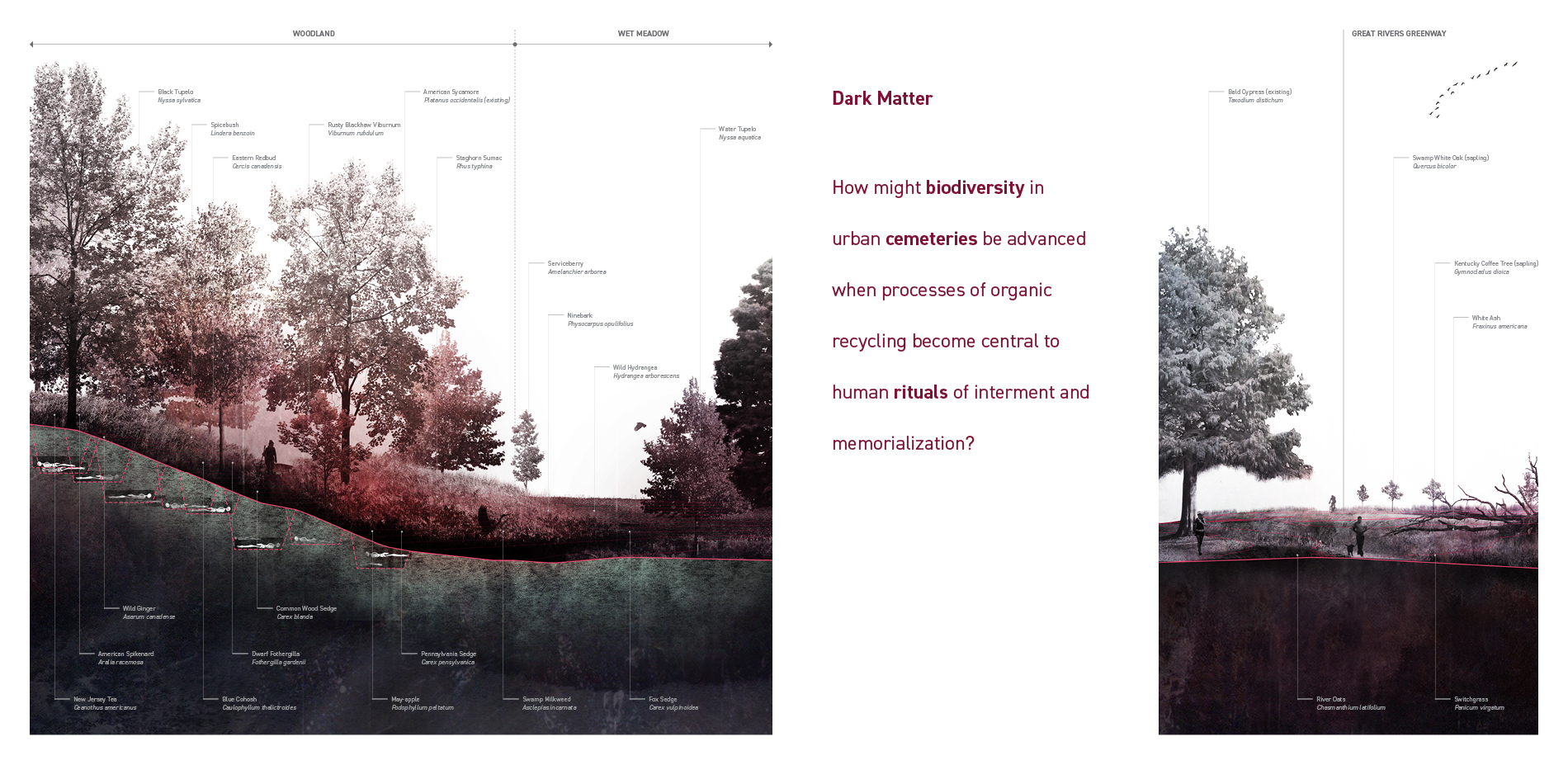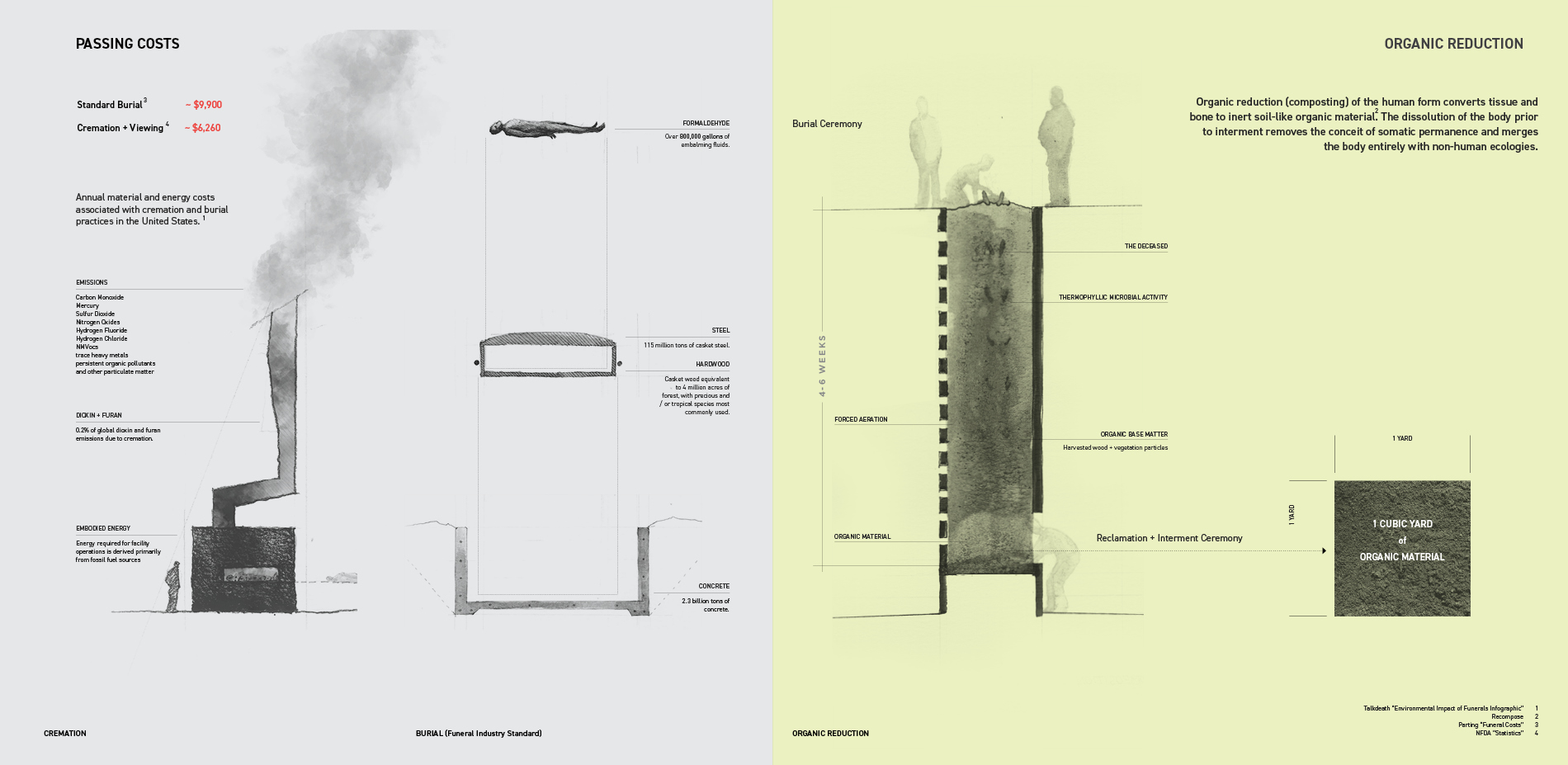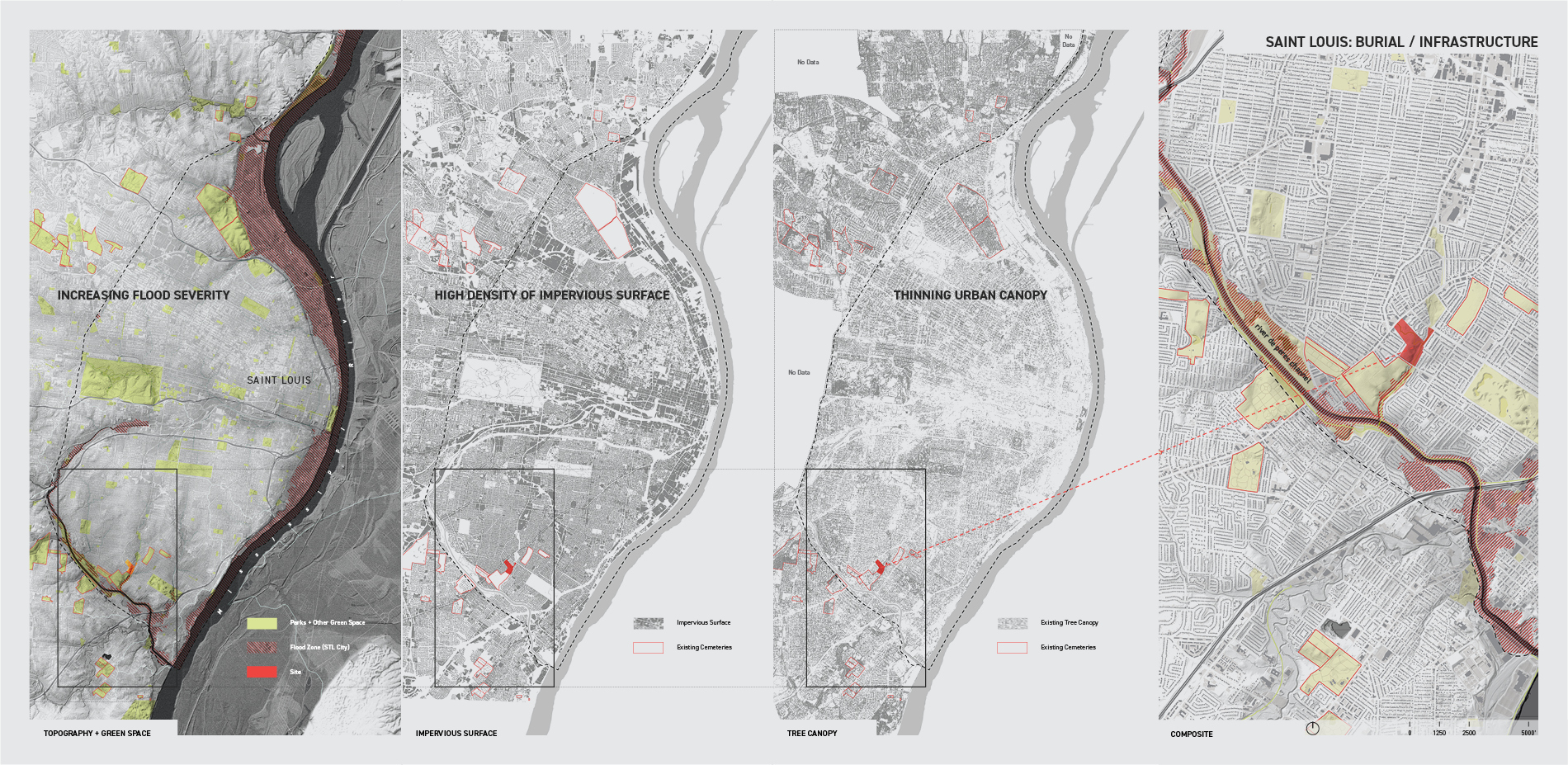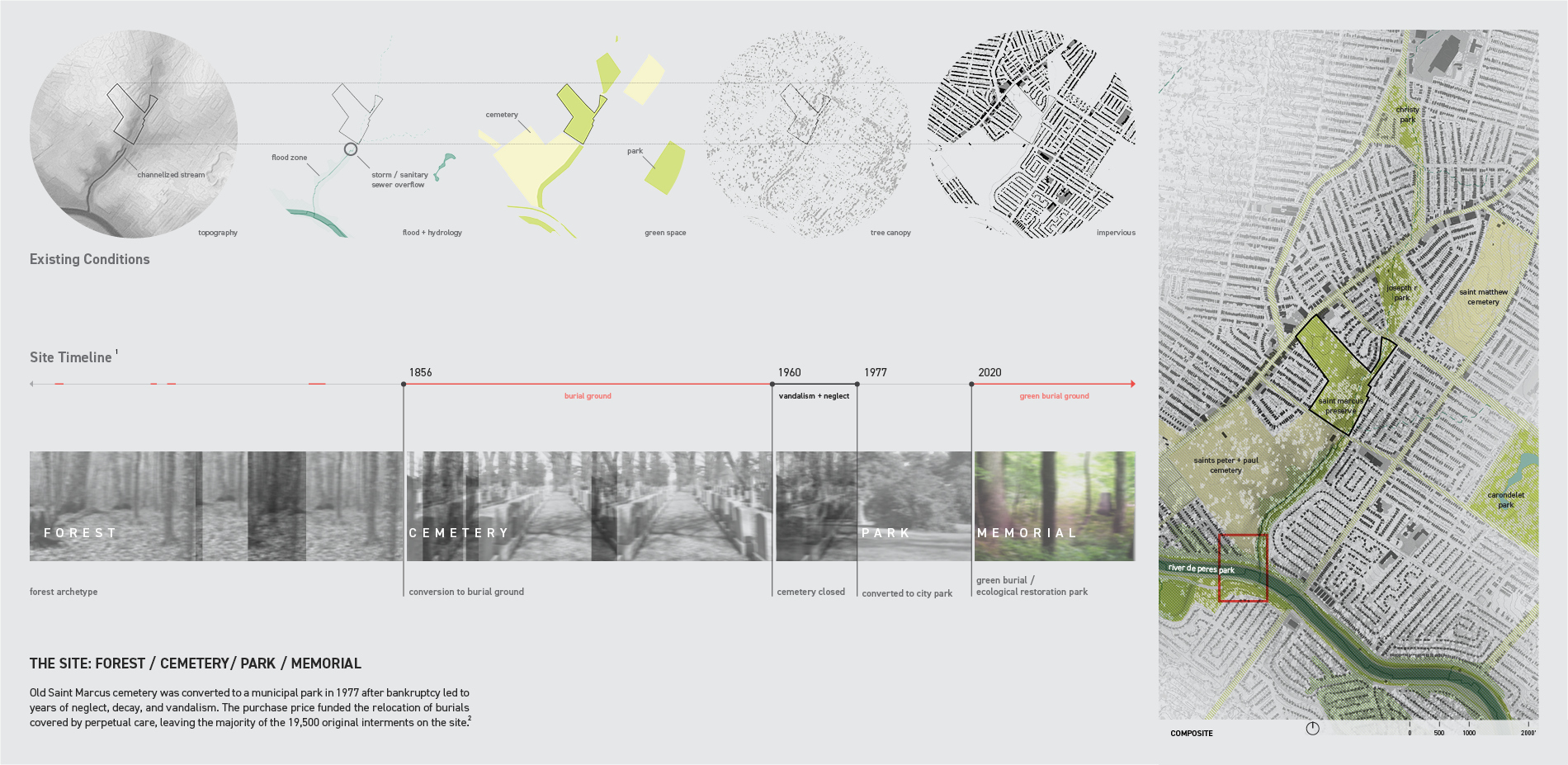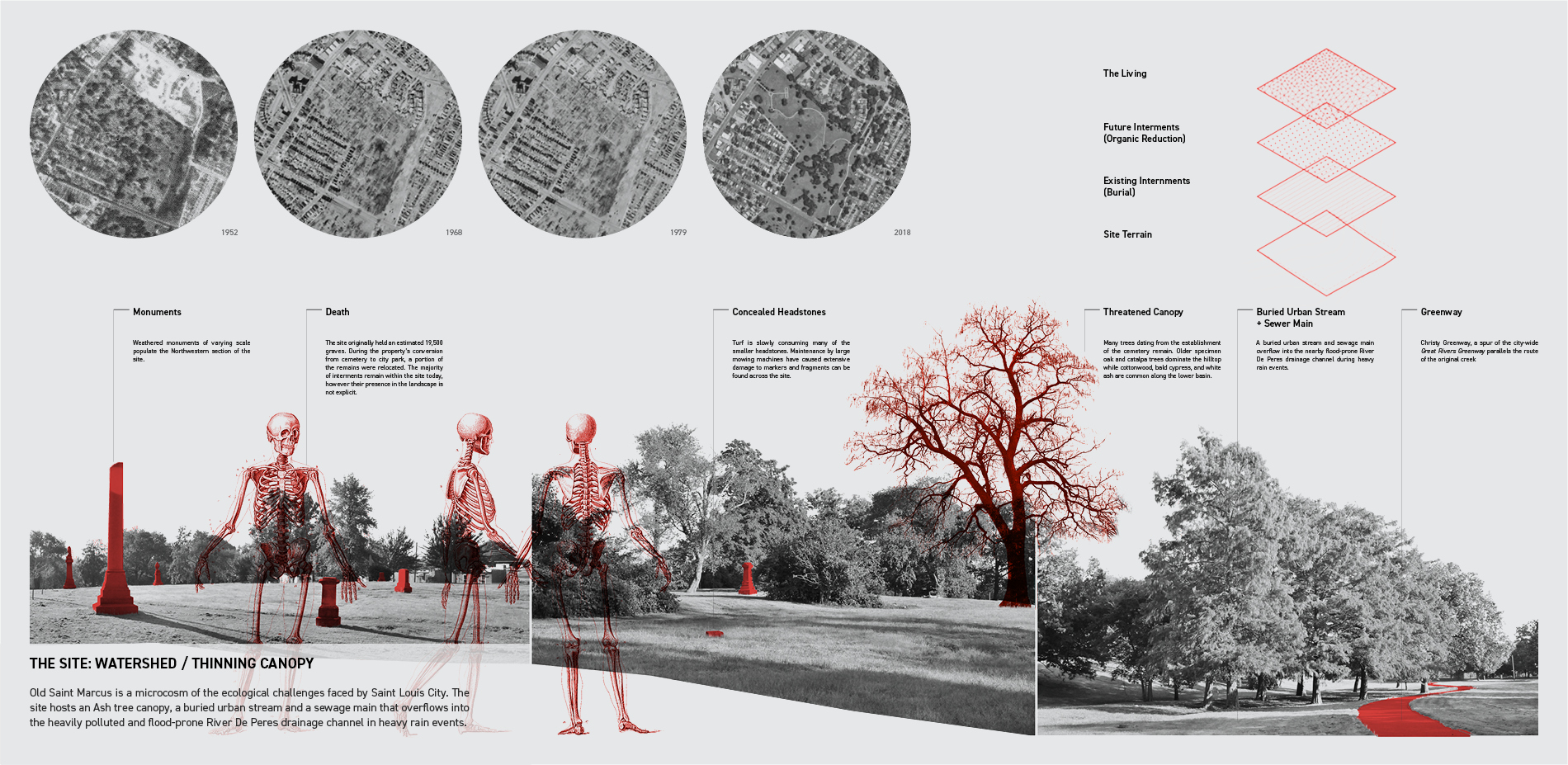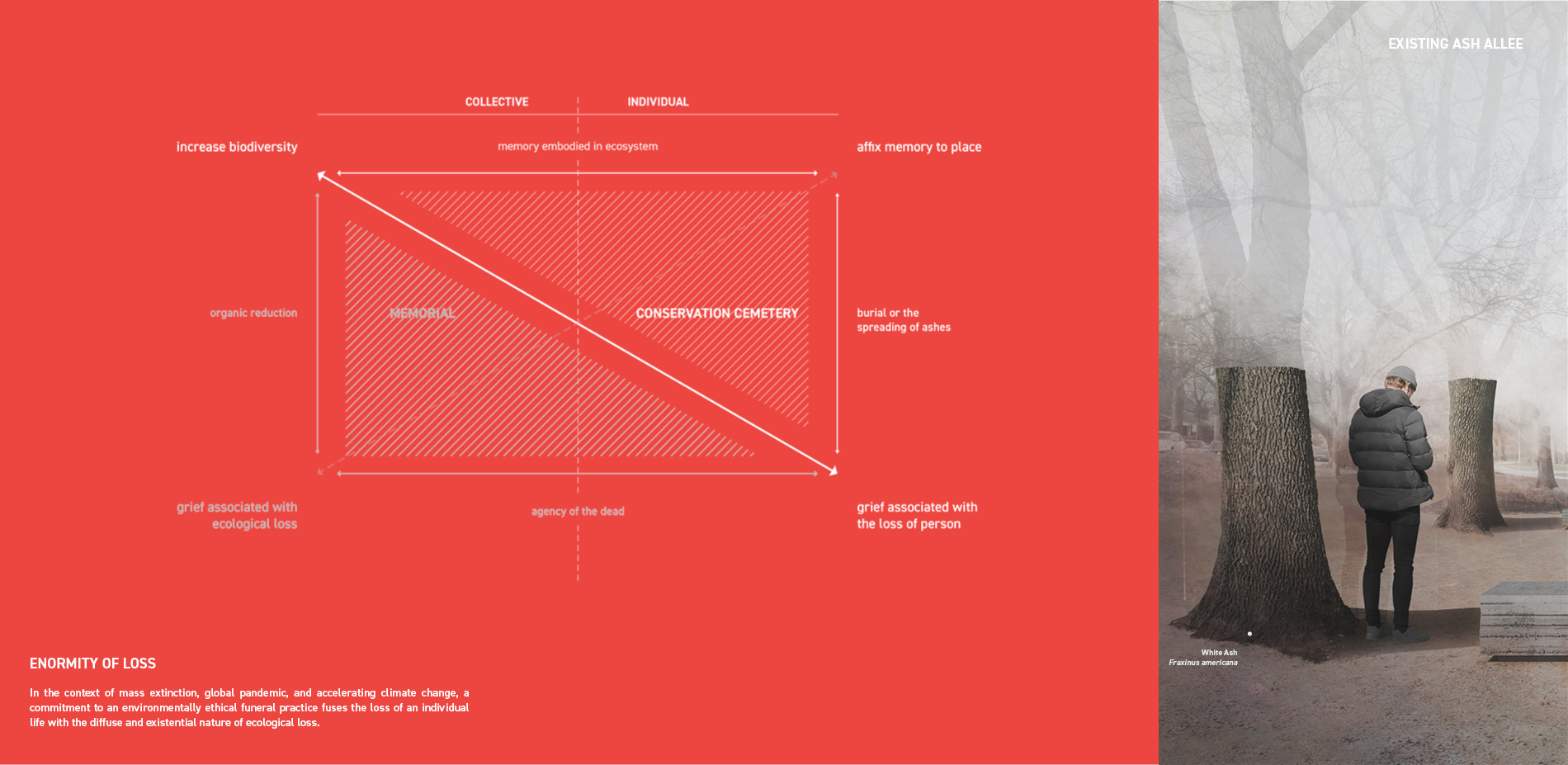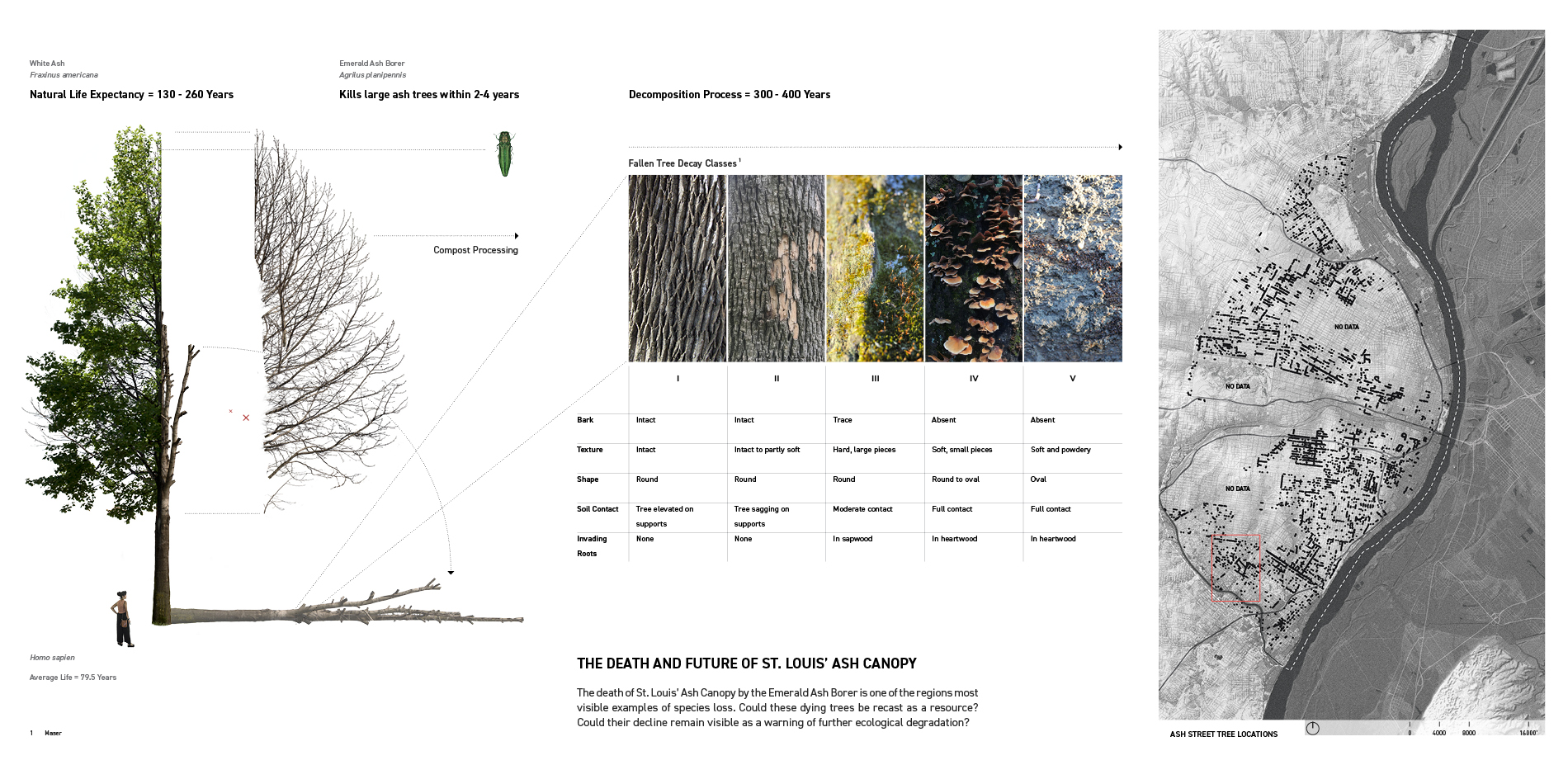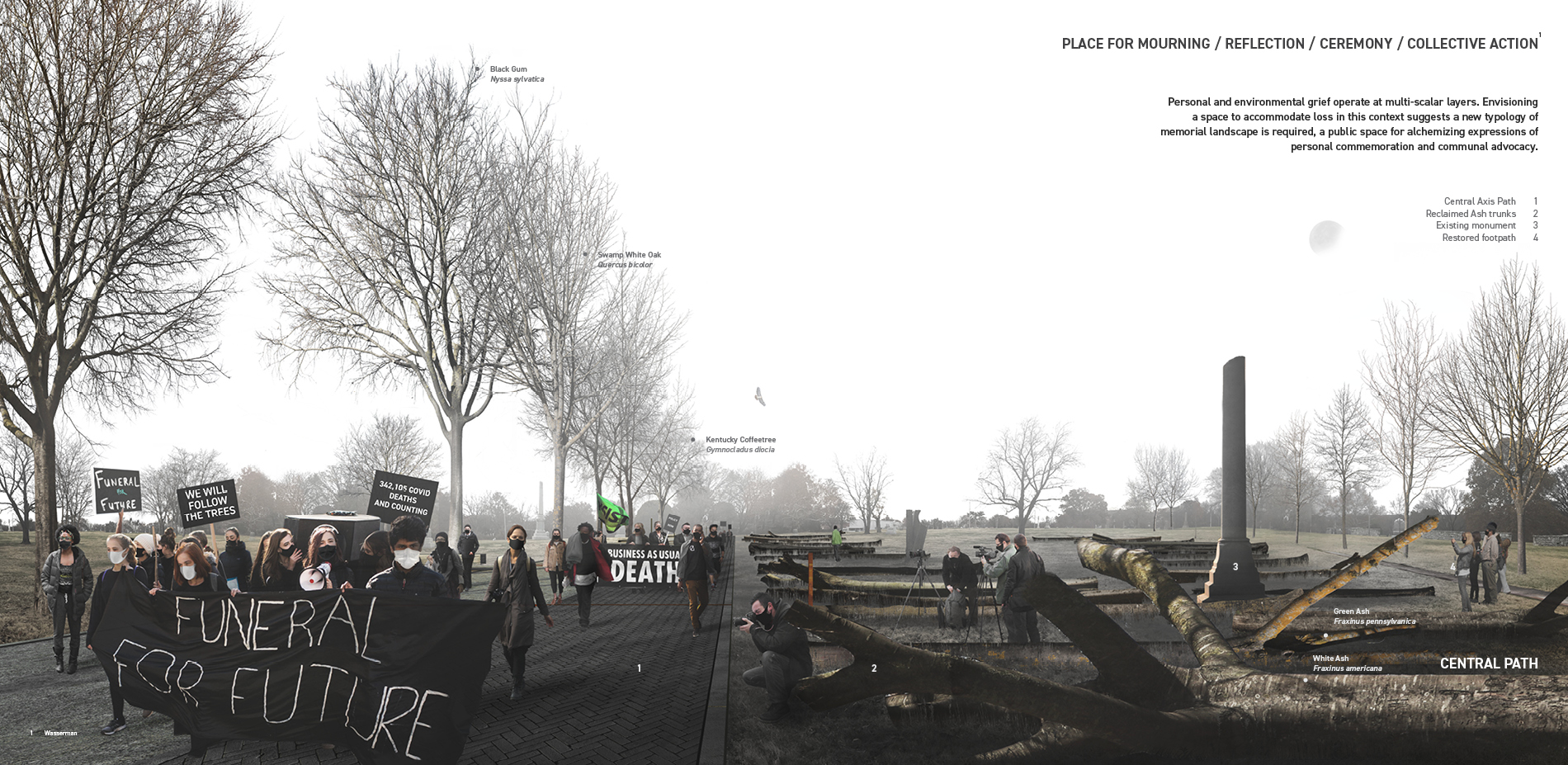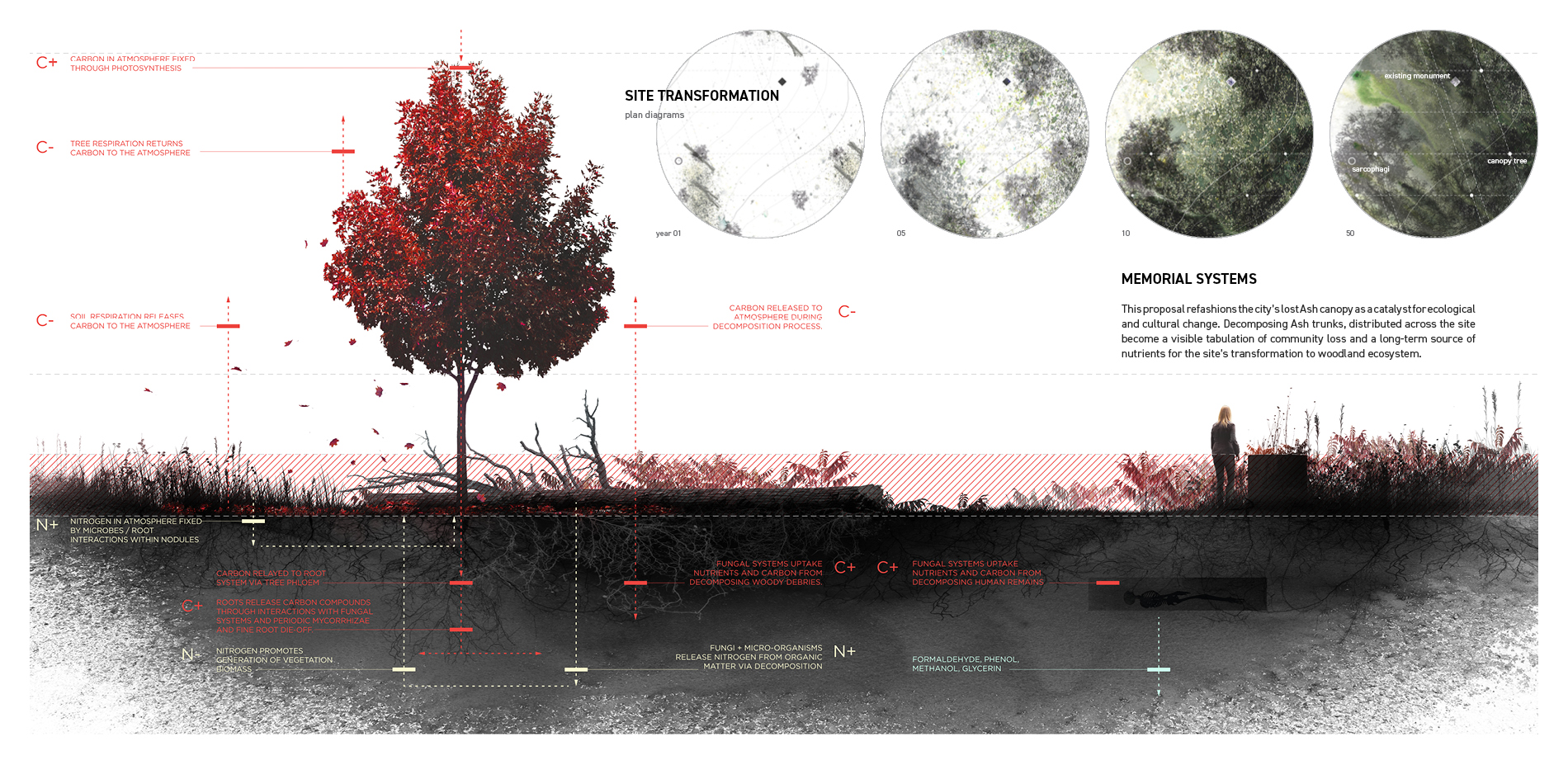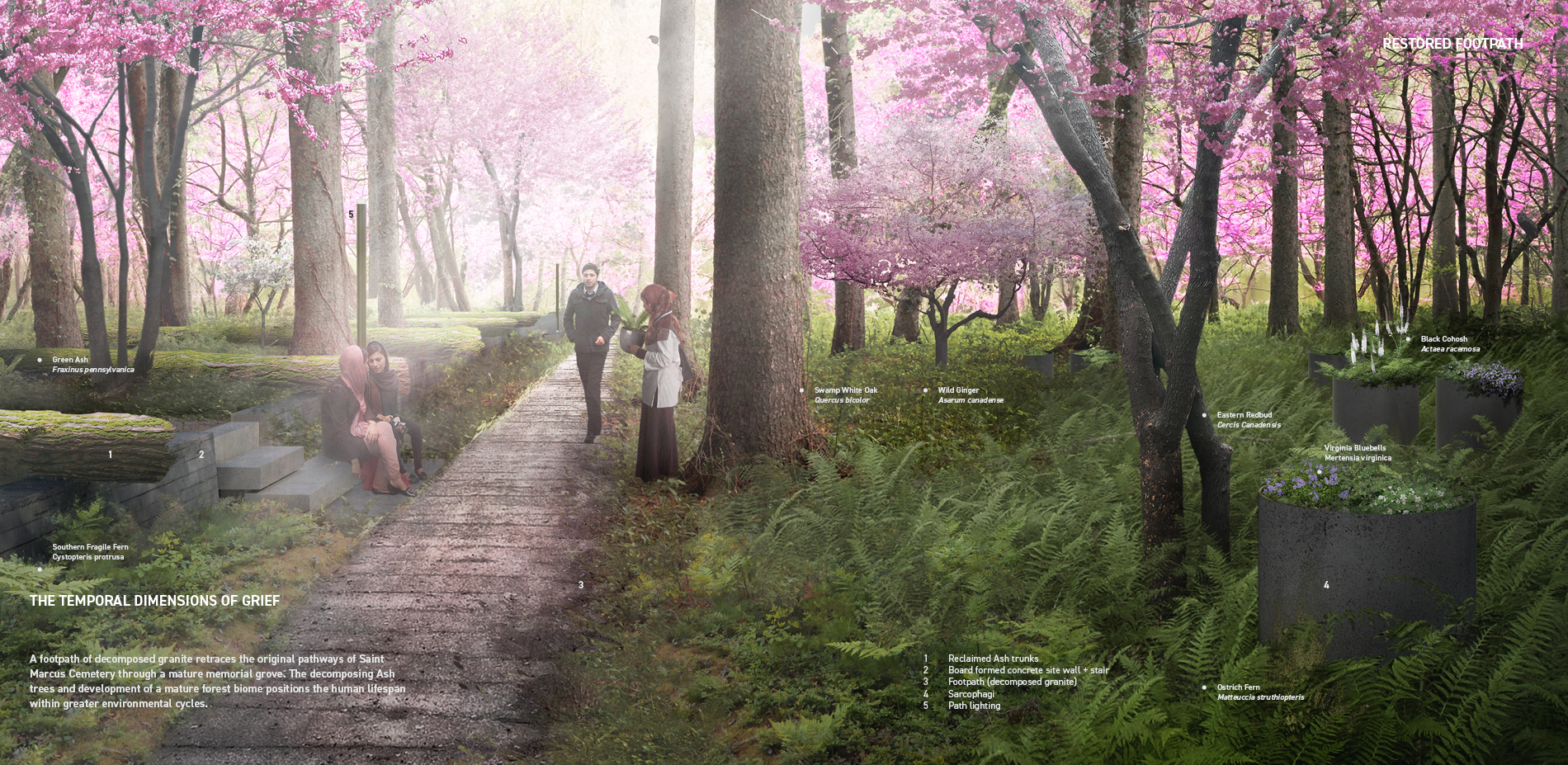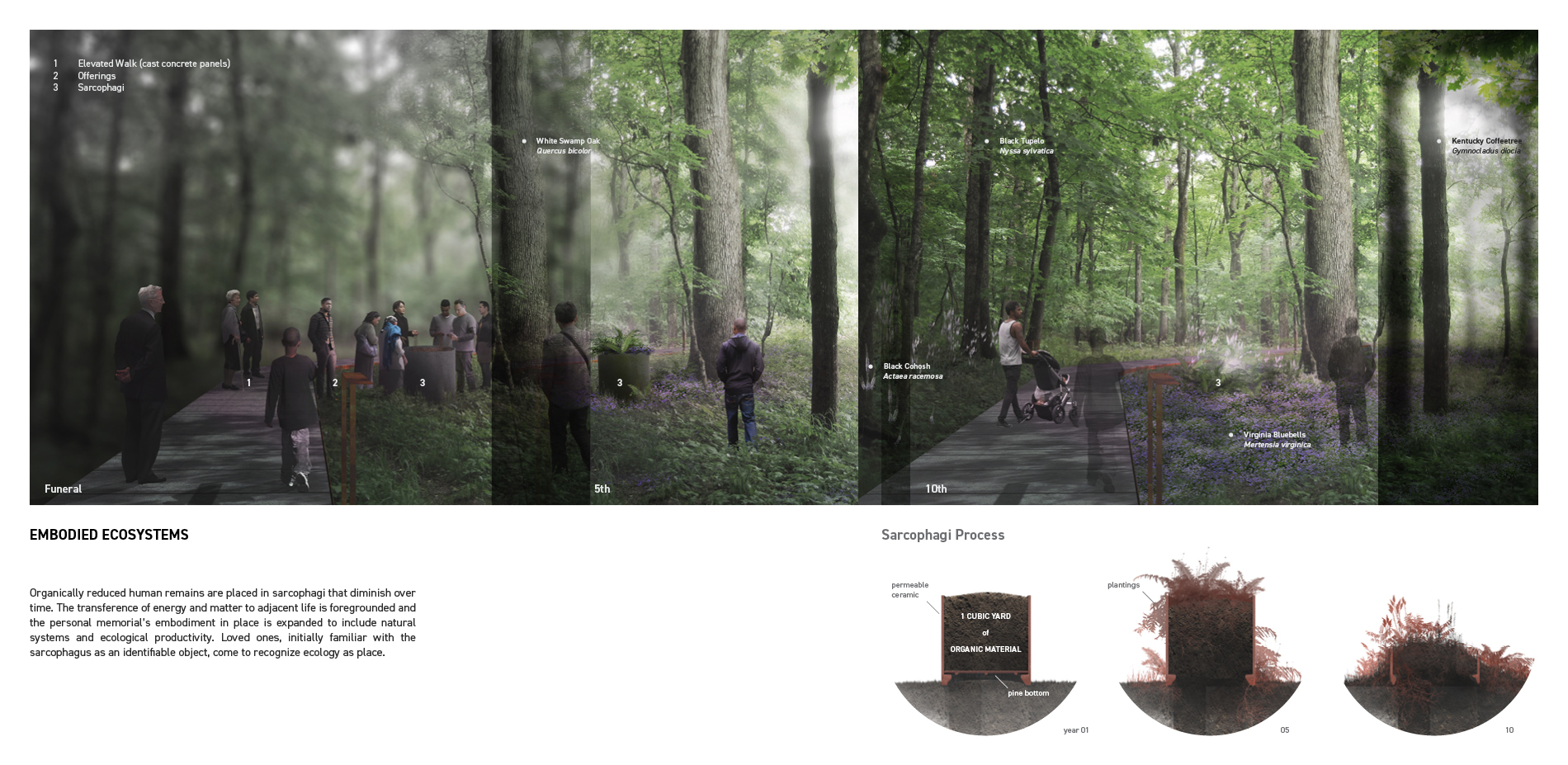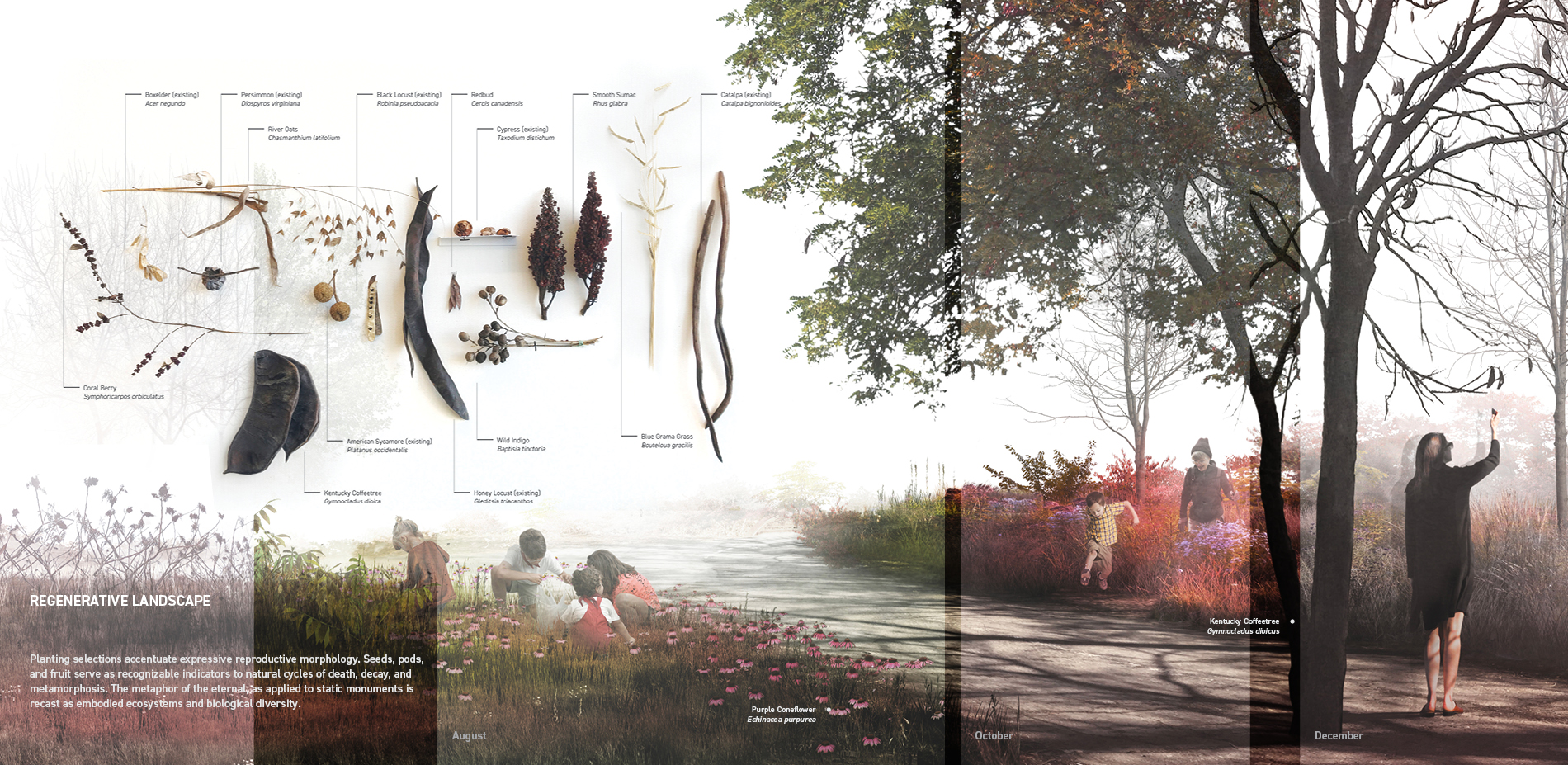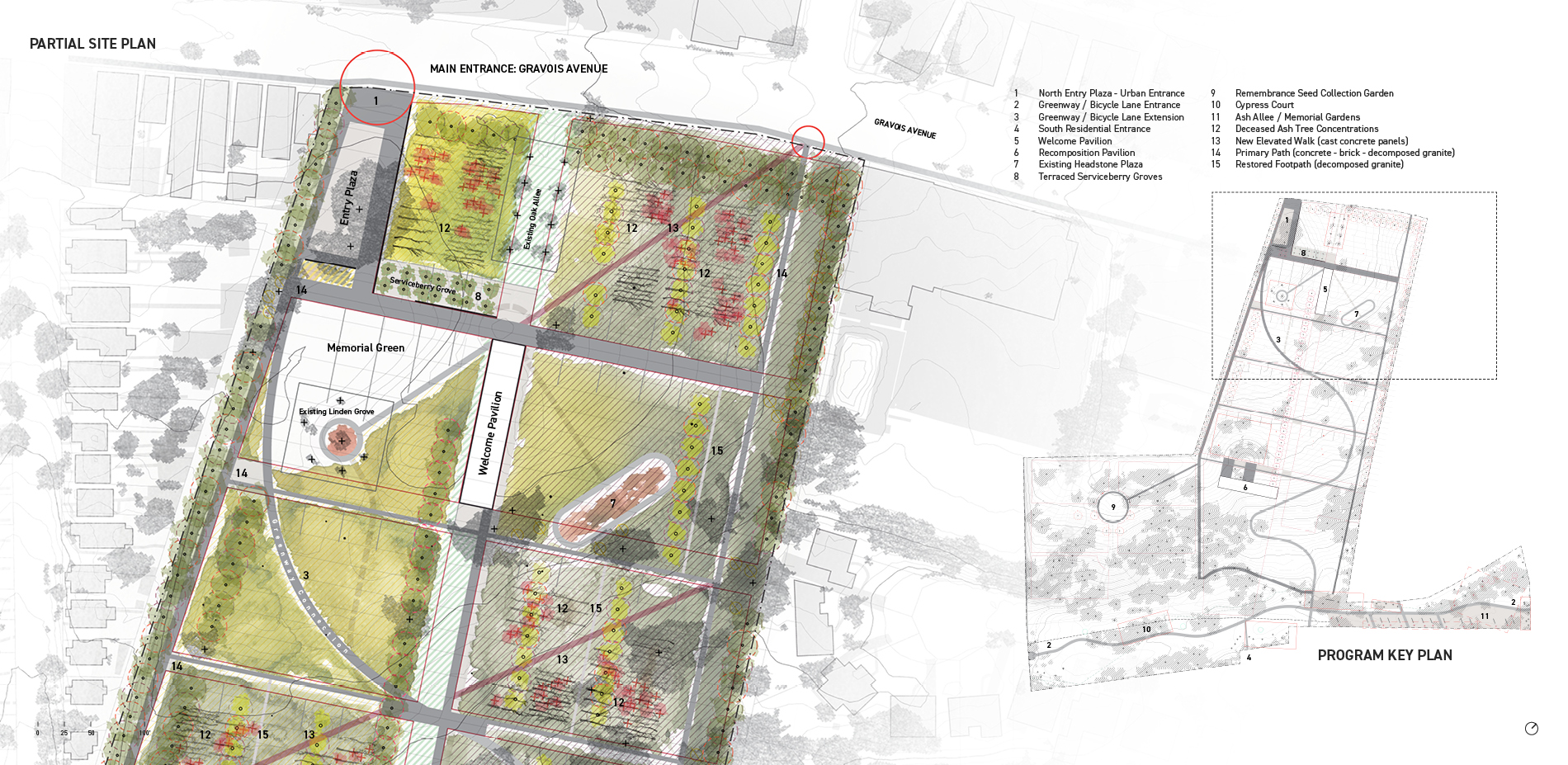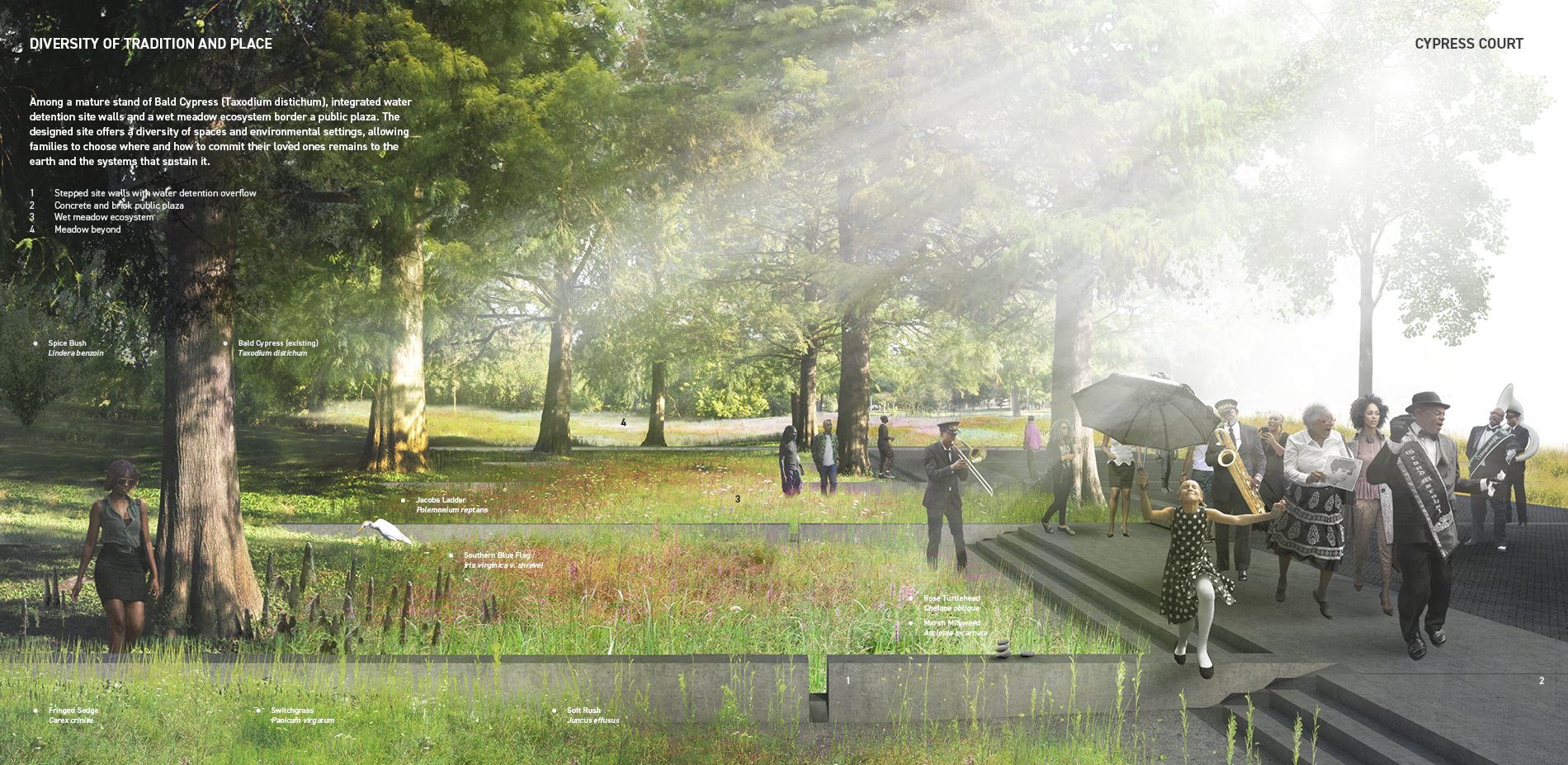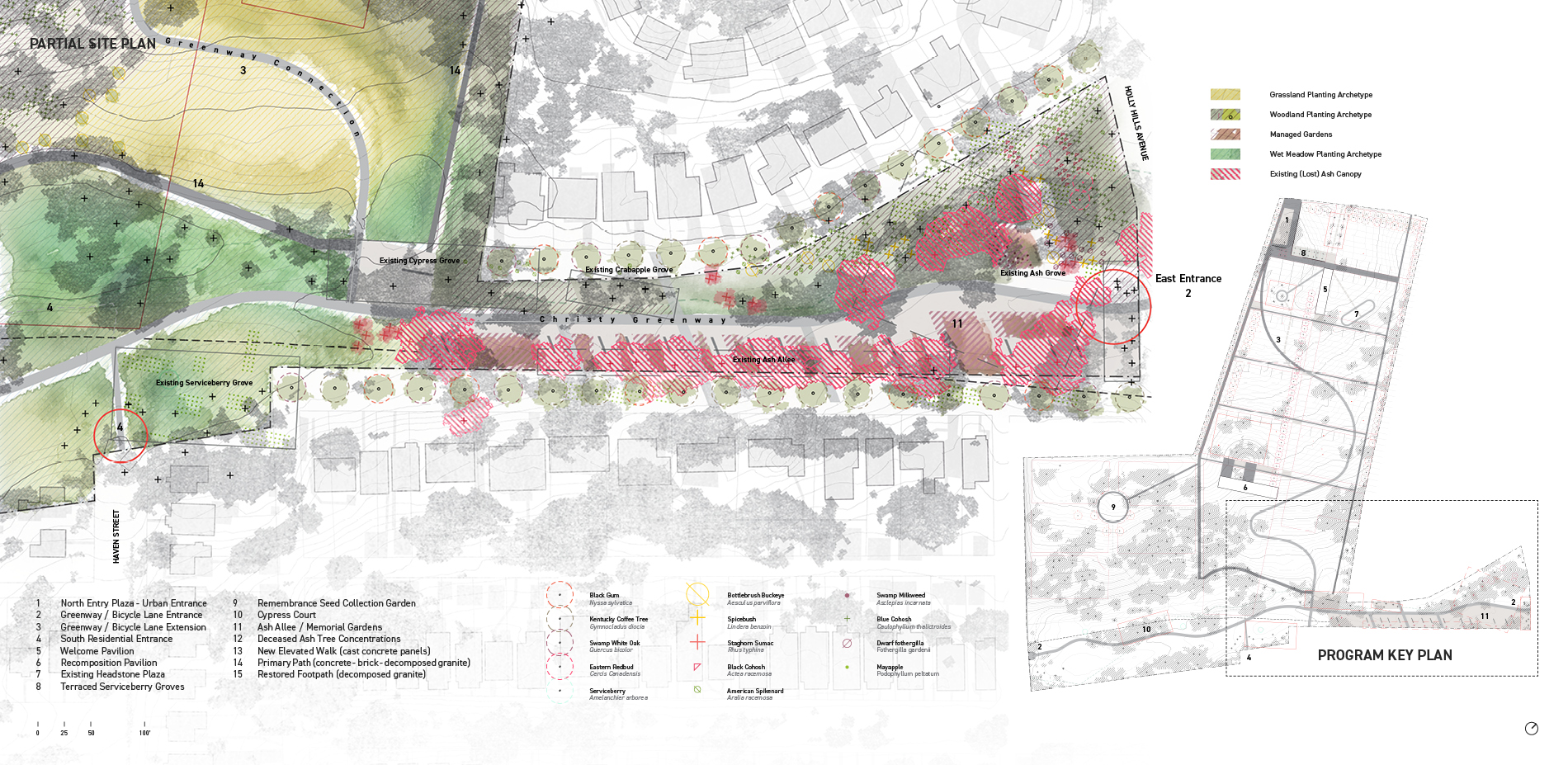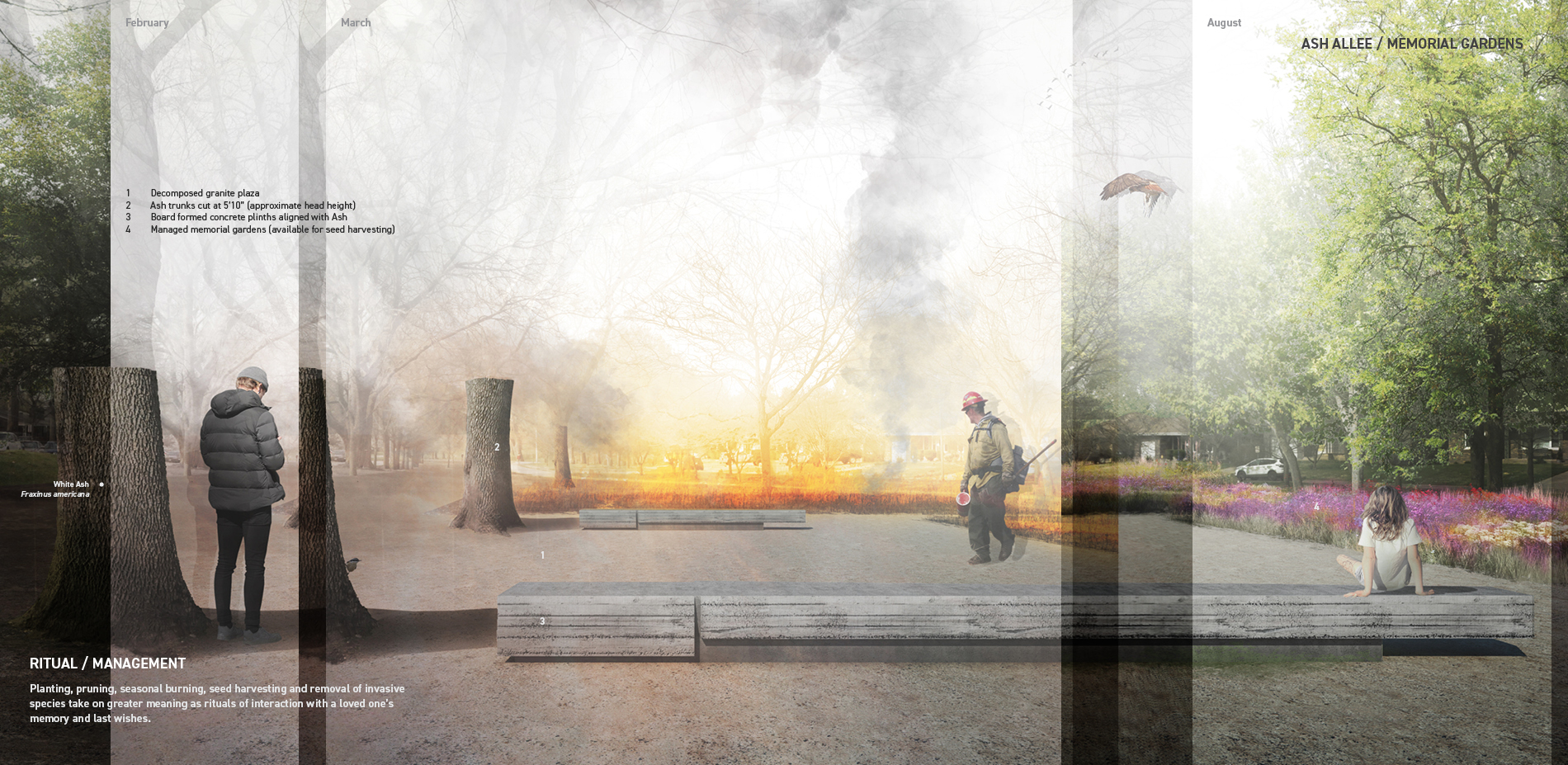Dark Matter
Award of Excellence
General Design
John Whitaker, Student ASLA
Faculty Advisors: Jacqueline Margetts
Washington University in Saint Louis
In the U.S., cemeteries were the first public parks, so it is perhaps a fitting turn that a cemetery in St. Louis, Missouri, that was once converted to a public park may now become a cemetery again. The idea of celebrating decay in lieu of life may be a foreign one to some, yet practices of burial or cremation might seem equally absurd in the context of global resource shortages, pandemics, and climate change. Ash trunks harvested from around the city dot a new landscape for diverse iterations of grief where the organic reduction of bodies into compost cultivates new life from the dead. The cemetery becomes an evolving terrain as opposed to static markers in a field.
- 2020 Awards Jury
Project Statement
Dark Matter investigates organic reduction as a means of promoting biological and cultural diversity in urban cemeteries. Dissolution of the body prior to interment foregrounds the transference of matter to adjacent life; the memorials embodiment of place is expanded to include natural systems and ecological productivity. The funerary landscape is decentralized from static site of memorial to evolving memorial system that invites engagement with the living.
In the context of mass extinction, climate change and global pandemic, an environmentally ethical funeral practice fuses the loss of individual with the diffuse and existential nature of ecological loss. These layered forms of grief operate at multiple temporal scales and suggest a new typology of memorial landscape that engages natural cycles of a duration that exceeds the human life. To address these forms of grief, this funerary landscape offers biodiverse public spaces that meaningfully rejoin bodily death to broader natural cycles of ecological metamorphosis. Rituals of commemoration, management, and activism would alchemize to unexpected results when program of memorial, ecological preserve, and space for collective action merge.
Project Narrative
Dark Matter, a research by design thesis, investigates organic reduction (composting) of human remains as a means of promoting biological and cultural diversity in urban cemeteries. The project is a comprehensive application of technological advancements within the green funeral industry to a site in the Boulevard Heights neighborhood of Saint Louis, Missouri. While the project cites and assumes the physical realities of the method pioneered by Katrina Spade and her company Recompose, the proposal imagines an accompanying landscape that accommodates the material application, the subsequent adaptation of cultural practices and the concerns of the recently deceased who have opted for this environmentally ethical funeral process. The design intervention seeks to dovetail this new typology of memorial landscape into the complexities of an existing burial site, neighborhood and city.
The practices of the contemporary American funeral industry come at a high financial and environmental cost. A standard burial averages $9,900; cremation with visitation is commonly above $6,000. Over 800,000 gallons of embalming fluids are buried in the United States annually, including formaldehyde, a known carcinogen. Additionally, 115 million tons of steel and the equivalent of 4 million forest acres of hardwood are buried in casket constructions. The most robust barrier between body and soil is the concrete vault, a common requirement from cemeteries or municipalities. Vault construction commits 2.3 billion tons of concrete to the earth every year. Commonly thought of as a more environmentally friendly option, cremation also leaves a troubling environmental legacy. Cremation is energy intensive, and the majority of crematoriums operate on fossil fuels. Emissions from a crematorium deliver a cocktail of chemicals, persistent organic pollutants, NMVocs and trace heavy metals such as mercury into the atmosphere.
The popularity of ‘green burials’ have steadily increased in the United States over the last two decades. Green burial practices minimize negative environmental impacts through forgoing the use of embalming fluids and requiring that only non-toxic and biodegradable materials accompany the body in the earth. In an additional step towards environmental responsibility, conservation cemeteries have committed burial fees to establish and grow public land trusts that preserve ecosystems and prohibit future development. The recently legalized practice of organic reduction relies on thermophyllic microbial activity to transform human tissue and bone into inert soil-like organic material over the span of 4-6 weeks. This transformation occurs down to a molecular level, and results in the complete dissolution of the human body prior to interment.
SITE
The proposed site, Old Saint Marcus Cemetery, is situated within a larger history of displacement and trauma associated with Saint Louis’s burial grounds. Originally a German Evangelical cemetery, Saint Marcus is one of a constellation of the oldest remaining cemeteries along the political border of Saint Louis City and County. Their geographical arrangement is a result of successive cholera epidemics, disproportionate investment, predacious development, and the city’s tortured history of racial suppression, segregation and disenfranchisement from slavery through the present. The dead were not exempt from the changing city’s impositions. Older urban burial grounds were routinely exhumed and bodies relocated to the perimeter of the growing city, only to be encroached upon and surrounded anew. Many older cemeteries have experienced bankruptcy and subsequent decline.
Saint Marcus was converted to a city park in 1977 after bankruptcy led to years of neglect, decay, and vandalism. The purchase funded relocation of burials under perpetual care, but left the majority of the original 19,500 interments on site. The original layout of cemetery paths and roads were removed and a curving path was installed to link the commercial Gravois Avenue to the North with the greenway and residential neighborhoods to the South. Large scale monuments and headstones remain on site though turf is slowly consuming many of the smaller markers. Saint Marcus hosts a microcosm of ecological challenges faced by the Saint Louis region. The most critical is the deterioration of the city’s urban tree canopy and an increasing frequency and severity of flood events.
EXPANDED FIELD OF GRIEF
In the anthropocene, an era of mass extinction, global pandemic, and accelerating climate change, an individual’s commitment to an environmentally ethical funeral practice is a deeply intentional final act that bares profound concern and empathy for the world they are leaving. The process of organic reduction removes any conceit of somatic permanence and allows the merging of human matter with non-human ecologies. This choice fuses the loss of an individual life with the diffuse and existential nature of environmental decline and ecological loss. A funerary site designed to accommodate this expanded field of grief suggests a new typology of memorial landscape is required, one that can accommodate personal and communal loss. The program of such a landscape must adapt to expressions of grief akin to mourning, reflection, ceremony, and collective action. The landscape must supply moments of spatial intimacy juxtaposed with experiences that position a human body within an immensity of time and ecological complexity.
The death of Saint Louis’ Ash trees by the Emerald Ash Borer is one of the regions most visible examples of ecological loss. Fraxinus spp. are the most prolific street tree in the city, over 18% or approximately 15,000 Ash shade the city’s avenues and parks. Dark Matter refashions the city’s lost Ash canopy as a resource and catalyst for ecological and cultural change. Ash trunks removed from around the city will be strategically distributed across the site. Their concentrated presence will initially register as a visible tabulation of the city’s loss and a warning against future ecological catastrophe. Over the following 300-400 years, as the site transforms into a mature woodland ecosystem the decomposing trees will serve as a source of nutrients supporting micro-organism, fungal, plant and insect biodiversity.
Organically reduced human remains may be applied to the site directly (in the manner of the spreading of ashes) or via a low-fired ceramic sarcophagus that diminishes over time. Funeral practices traditionally seek to ascribe the memory of an individual to a geographic place, commonly through the locating of a ‘permanent’ marker. The sarcophagus functions similarly, an identifiable object in the landscape that embodies an individual’s memory. Loved ones are encouraged to plant native species within the sarcophagus, expressing their agency by adding personalization, while contributing biodiversity to the cemetery. Within a year, the soft pine bottom of the sarcophagus decomposes to allow interface between remains and soil. Within 10 years, the low-fired ceramic weathers and erodes, foregrounding the transference of matter to adjacent life, and allowing the biomass to slump into a mound-like form in the landscape. Loved ones who frequent the site will initially use the sarcophagus itself to identify their loved one’s burial place, but over time, recognition of embodied place will expand to encompass present trees, plantings, natural systems and ecological productivity.
Katrina Simon has written that cemeteries “exist to be read” and that funerary landscapes “reflect as well as shape human experience, in all of its diversity and ambiguity, and what we know or believe about death will shape the landscape of death, as well as how we read or experience it.” The redesigned Saint Marcus Memorial Preserve provides a variety of loosely programmed spaces as settings for families and communities to adapt traditions and practices to designed ecosystems. A variety of ecological and spatial settings provide families the opportunity to choose where and how a loved one’s remains are committed to the earth and the systems that sustain it. The site’s designed plant communities accentuate expressive reproductive morphology. Seeds, pods, and fruit serve as recognizable indicators to natural cycles of birth, death, decay, and metamorphosis. Idiomatic rituals of interacting with landscape through planting, pruning, seasonal burning, seed collection and removal of invasive species take on greater meaning as acknowledgments of a loved one’s memory and last wishes. These unplanned ‘cultural overlays’ will deepen the experience of place and contribute to fostering biodiversity.
